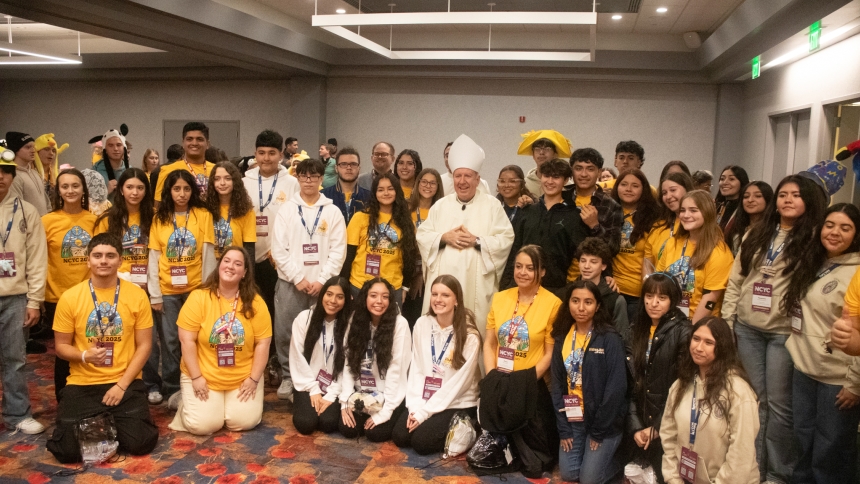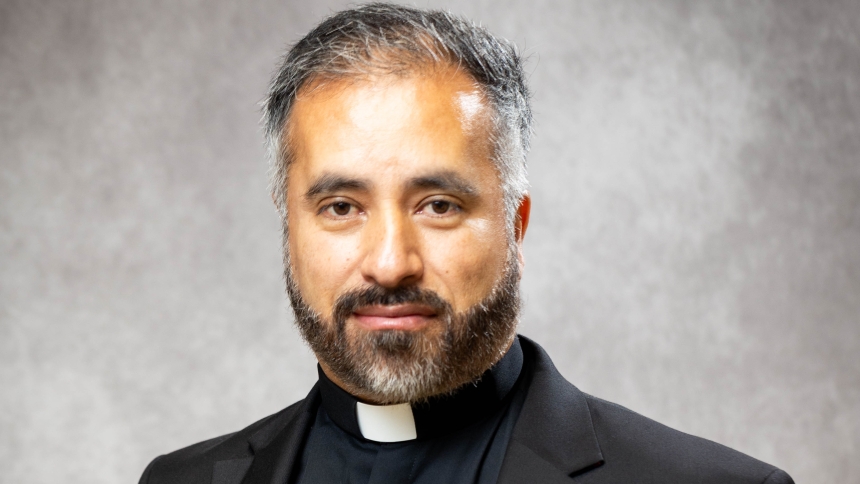
The Jubilee Year 2025, themed "Pilgrims of Hope," encourages Catholics to embark on pilgrimages, either to Rome or to designated sites within their local dioceses, as a way to experience spiritual renewal and seek God's mercy. Within the Diocese of Gary, Bishop Robert McClory has designated six parishes as pilgrimage churches. These locations remain ready to welcome faithful this summer.
1. Cathedral of the Holy Angels in Gary – Holy Angels parish was founded in 1906. The current church structure was then elevated to a cathedral when the Diocese of Gary was established in 1956. Entering through the narthex, one is led to the baptismal font and then called forward to the altar to be fed during Holy Communion. Visitors will also notice the cathedra, or bishop’s chair, on the altar, symbolizing the seat from which the shepherd of the local Church views the work of Christ carried out by his members.
The cathedral is open all day on the first Friday of every month during the jubilee year for adoration and confessions.
“Personally, the quiet of the church, the opportunity to go to confession, and the opportunity for prayer is so fulfilling,” said Eileen Wayte, administrative assistant. “My brain runs a million miles a minute, but not in the Cathedral.”
She added, “I’ve not gotten to come to every First Friday (I am off on Fridays), but when I do, I could just sit there all day. And, actually, if you want to sit there all day, you can!”
2. St. John the Baptist in Whiting – St. John the Baptist is located on Lincoln Ave. near the heart of the Whiting community. Those visiting the parish for the first time are encouraged to take a look around the beautiful church, spend time in the grotto and visit the Centennial Room. The parish has welcome books, typically in the pamphlet racks, that explain the beautiful architecture of the church.
“It’s interesting that immigrants, Catholic pilgrims from Slovakia settled in Whiting, for the industrial work opportunities,” said Margaret Saliga, SJB director of faith enrichment. “Having brought their deep Catholic faith with them, they wanted a church in which to worship.”
The parish was established in 1987 in a small edifice located on the present parcel of land, but it wasn’t large enough to accommodate the faithful. The church today was built in 1929 with architectural plans designed by Herman Gaul. However, most of the construction was the work of the skilled Slovak Catholic immigrants who were bricklayers and wood workers.
Upon entering, people are often amazed by the grandeur of the interior which boasts beautiful stained-glass windows, each with a history and a story, each reflecting the glory of God. The large baldachin draws one’s immediate attention to the tabernacle where the risen Lord is present in the Holy Eucharist. The woodworking craftsmanship is also seen around the icons of Mary and Joseph, the confessionals and the side altars.
“To enter St. John church is to enter the Holy of Holies, where God’s presence is immediately felt,” Saliga said. “All are invited to make a pilgrimage, knowing that a pilgrim people constructed a place of beauty to give glory to God for all generations.”
Special tours of SJB Church will be given by Saliga on July 26 at 11 a.m and 1 p.m It is hoped that visitors will decide to come that day or also on the 1st Friday of each month when the church is open for Eucharistic adoration from 2-6 p.m.
Saliga said, “Surrounded by the glow of candles and the gentle beauty of angels and saints depicted by stained glass and statuary. All remind the faithful of the presence of the Communion of Saints and the powerful presence of our God.”
3. Carmelite Monastery in Munster – After World War II, for various reasons, a few Carmelite monks from the Polish province found themselves in western Europe. In 1948, three of them arrived in the United States and started work in American monasteries. In the following year, supported by Father Provincial Anzelm Gadek, they decided to establish a Polish monastery in the USA to work among a new wave of Polish post-war immigrants. In 1949, they opened a house in Hammond, and in 1952, they moved to Munster.
Only after 1956 were closer contacts of the new monastery with the Polish province possible. Since 1957, from time to time, Polish monks have been joining the community in Munster. The pastoral work of the community was concentrated on the work in the community’s own chapel, serving organized retreat and pilgrimage groups, pastoral care of Polish societies, as well as help in Chicago parish churches, mainly Polish ones.
As the time went on, a number of constructions were completed, such as an attractive Virgin Mary’s cave, Stations of the Cross route with Calvary and the tomb of Jesus, a church (1972), a new monastery (1981), a chapel devoted to Virgin Mary of Sharp Gate in Vilnius, and a chapel of the Podhale (Polish highlands) region. The shrine is open daily from 9 a.m. to 4 p.m.
4. St. Matthias in Crown Point – St. Matthias is a welcoming, dynamic Roman Catholic parish of people of all ages centered around the Eucharist. It is made up of people of multiple backgrounds, from students to professionals, infants to senior adults, blue-collar workers to executives, and more.
The parish was named in honor of St. Matthias, the secondary patron of the diocese, as it was on his feast day, Feb. 25 in 1957, that Bishop Andrew Grutka was installed as the first bishop of Gary. The church was dedicated by Bishop Grutka on May 22, 1983.
The church is located at the intersection of Main and Burrell streets, across from Crown Point High School. Visitors are welcome to stop by during business hours to learn more about the parish and see the parish center.
5. St. Paul in Valparaiso – According to the parish’s website, much of the early life of the St. Paul community can be identified by the building of the railroads through Valparaiso. The Irish and French came to the area as part of the railroad construction. The result was the little parish of St. Paul, ministering to about 200 families.
The first Mass was celebrated in the 1850s at the P.T. Clifford farm, usually held outdoors. Between 1853 and 1857, Holy Cross priests from Notre Dame came to serve the people. Fathers Cointet, J. Curley, E.B. Kilroy, E. LeVeque and Paul Gillen came to serve. The latter served as pastor from 1857 to June 1858, and it was through his efforts that St. Paul Parish was established and named in honor of him and the Apostle Paul.
On Oct. 27, 1967, the third St. Paul church was dedicated. According to the dedication program, “the church of St. Paul is strikingly modern, yet planned according to the oldest principle of church architecture. The new St. Paul’s structure could have been built only with the tools of modern technology, and it demonstrates, in a forceful manner, what the contemporary architect and workman can do. It, too, has its place in the worship of God.”
“As a Jubilee church, If you attend any Sunday Mass during this Jubilee year, you will find the relics of St. Peter and St. Paul in the sanctuary for veneration,” said Father Doug Mayer. “For those not going to Rome, this may be of spiritual value to them.”
The pastor shared that the church also has the large folio books (2 Vol.) that were published of the freshly cleaned Sistine Chapel and other sites at the Vatican. Each week, the pages of one volume are flipped so visitors can look closely at the art created by Michangelo.
“We hope that those who join us for Mass have a rich, faith-filled encounter with our Lord,” said Father Mayer.
On First Fridays, the parish holds Eucharist adoration from 9 a.m to 4 p.m., except July 4.
6. Queen of All Saints in Michigan City – Queen of All Saints in Michigan City is a sacred and inviting destination for pilgrims seeking to encounter the living Christ. At the heart of the parish is a deep love for the Eucharist, made visible in the new Christ the King Chapel, where Eucharistic Adoration is offered throughout the day, every day.
“Many who sit quietly before the Blessed Sacrament in this chapel experience a profound sense of peace, healing, and renewed faith,” said associate pastor Zachary Glick.
Pilgrims are also welcomed into the Legacy Center, a beautiful, light-filled gathering space that connects the chapel and the main church. With cozy couches, coffee tables, and a warm atmosphere, it’s the perfect place for fellowship, reflection or quiet conversation with fellow pilgrims in faith.
Inside the main church, hearts are lifted in prayer by the striking new sanctuary crucifix – a powerful reminder of Christ’s sacrificial love. Along the walls, our newly installed Stations of the Cross invite pilgrims to walk prayerfully with Jesus in His Passion.
“We hope that every soul who visits Queen of All Saints will come away deeply touched by the Real Presence of Jesus in the Eucharist, strengthened in their trust in His mercy, and renewed in their mission to live the Gospel with joy,” said Father Glick. “Whether you come alone or with a group, this is a place where Heaven draws near. Make the pilgrimage. Come encounter Christ.”
Learn more about making a jubilee pilgrimage at https://dcgary.org/NWIJubilee.https://dcgary.org/NWIJubilee



